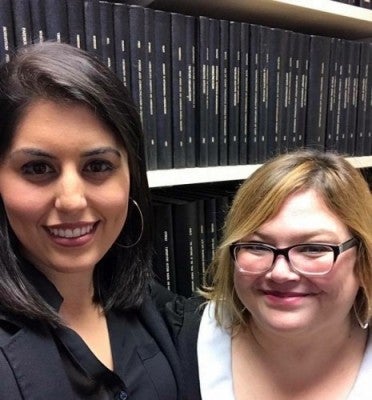The Middle East, Feminism … and Vampires?
This is not your typical Hollywood vampire love story. Bernadette Calafell and Shadee Abdi were captivated by the story of an Iranian vampire in “A Girl Walks Home Alone at Night” and how the film flips the script on the Middle East, feminism and what it means to be labeled a monster.
In their article "Queer utopias a (Feminist) Iranian vampire: a critical analysis of resistive monstrosity in A Girl Walks Home Alone at Night," Calafell and Abdi describe the film as a, “black and white vampire spaghetti western … [following] the narrative of the Girl, a forlorn chador-wearing feminist-vampire-vigilante in the fictional world of Bad City. In this queer utopia, the Girl preys on immoral men so that she can protect the female residents of Bad City from the violence of patriarchy.”
Calafell, a professor of communication studies, had just finished teaching her Monsters and Pop Culture class — where she asks students to question traditional representations of monsters — when she and her PhD student advisee, Abdi, saw “A Girl Walks Home Alone at Night.” They both knew immediately that they wanted to collaborate on an article.
Not only was the film visually striking, but it also presented layers of complexity and meaning, including the representation of an Iranian woman — who happens to be a vampire — being empowered by her chador, a long, loose full-body cloak.
“Normally these women are seen as victims, and this film was such a disruption of that narrative,” Calafell says.
“She’s kind of a superhero … really trying to do good and fight the patriarchy,” Abdi adds.
As a professor and author, Calafell brought to the joint effort a deep knowledge of monstrosity and queer utopias. Abdi, meanwhile, provided her personal Iranian-American perspective, the ability to translate cultural nuances and Farsi, and her own scholarly expertise on Iranian women and feminism.
“I wanted to work with Shadee because she is such a strong scholar and has an intimate relationship with the culture,” Calafell says. Working collaboratively came easily, as the two had already established a relationship as advisor and advisee.
“I chose DU specifically because I wanted to work with Bernadette,” Abdi says. “She is one of the best people I’ve ever collaborated with, in that she is really open to ideas, she is well-published, and she is one of the great voices of cultural communication.”
Their collaboration also provided Calafell an opportunity to mentor Abdi on how to publish her work, thus increasing her competitive edge upon graduation. Getting their article published was a challenge at first. They faced rejection on their first attempt and multiple revisions on their second attempt. They had to make significant decisions about what to cut or change, and ultimately, about what was most important to them.
Through this process, Calafell and Abdi were forced to think beyond their preconceived ideas. It pushed them to produce an even stronger article, one that challenges others to question their own perceptions.
“It’s important to me to change the narrative around the Middle East and North Africa in general, and how we perceive it and how it is written about in research. And for me, it’s really important to reframe these conversations in a way that is not demonizing of the region or the culture as a whole. It’s my culture,” Abdi explains.
“The biggest thing I was hoping to accomplish with the article was to get people to shift the popular frame away from Middle Eastern and North African women as victims or lacking agency,” said Calafell. “And, to get people to think about challenging the images of what a vampire could be, that every day monsters could be more than just what they immediately look like.”








